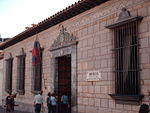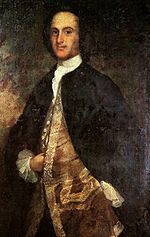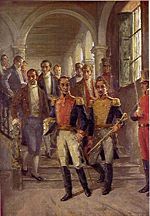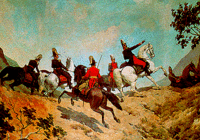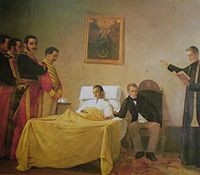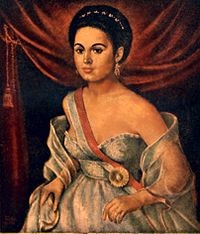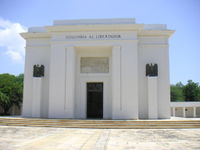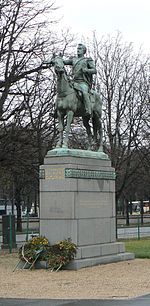
Simón Bolívar
Did you know...
This wikipedia selection has been chosen by volunteers helping SOS Children from Wikipedia for this Wikipedia Selection for schools. SOS Children has looked after children in Africa for forty years. Can you help their work in Africa?
| Simón Bolívar | |
|---|---|
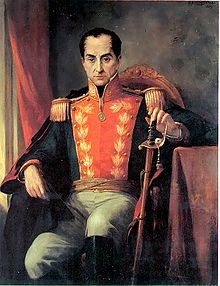 |
|
| President of Gran Colombia | |
| In office December 17, 1819 – May 4, 1830 |
|
| Vice President | Francisco de Paula Santander |
| Succeeded by | Domingo Caycedo |
| President of Bolivia | |
| In office August 12, 1825 – December 29, 1825 |
|
| Succeeded by | Antonio José de Sucre |
| President of Peru | |
| In office February 17, 1824 – January 28, 1827 |
|
| Preceded by | José Bernardo de Tagle, Marquis of Torre-Tagle |
| Succeeded by | Andrés de Santa Cruz |
| Personal details | |
| Born | July 24, 1783 Caracas, Captaincy General of Venezuela, Spanish Empire |
| Died | December 17, 1830 (aged 47) Santa Marta, New Granada |
| Spouse(s) | María Teresa Rodríguez del Toro y Alaysa |
| Religion | Roman Catholic |
| Signature |  |
Simón José Antonio de la Santísima Trinidad Bolívar y Palacios Ponte y Blanco (24 July 1783 – 17 December 1830), commonly known as Simón Bolívar (Spanish pronunciation: [siˈmon boˈliβar]), was a Venezuelan military and political leader. Bolívar played a key role in Latin America's successful struggle for independence from the Spanish Empire, and is today considered one of the most influential politicians in the history of the Americas.
Following the triumph over the Spanish monarchy, Bolívar participated in the foundation of the first union of independent nations in Hispanic-America, a republic, which was named Gran Colombia, of which he was president from 1819 to 1830. Bolívar remains regarded in Hispanic-America as a hero, visionary, revolutionary, and liberator. During his lifetime, he led Venezuela, Colombia (including Panama at the time), Ecuador, Peru (together with Don José de San Martín), and Bolivia to independence, and helped lay the foundations for democratic ideology in much of Latin America.
Family history
The surname Bolívar derives from the Bolívar aristocrats who came from a small village in the Basque Country, Spain, called La Puebla de Bolívar. His father came from the male line of the de Ardanza family. His maternal grandmother was descended from some families from the Canary Islands that settled in the country.
The Bolívars settled in Venezuela in the sixteenth century. His first South American Bolívar ancestor was Simón de Bolívar (or Simon de Bolibar; the spelling was not standardized until the nineteenth century), who went to live and work with the governor of Santo Domingo from 1550 to 1570. When the governor of Santo Domingo was reassigned to Venezuela by the Spanish Crown in 1589, Simón de Bolívar came back with him. As an early settler in Caracas Province, he became prominent in the local society and he and his descendants were granted estates, encomiendas, and positions in the Caracas cabildo.
The social position of the family is illustrated by the fact that when the Caracas Cathedral was built in 1594, the Bolívar family had one of the first dedicated side chapels. The majority of the wealth of Simón de Bolívar's descendants came from the estates. The most important of these estates was a sugar plantation with an encomienda that provided the labor needed to run the estate. Another portion of Bolívar wealth came from the silver, gold, and more importantly, copper mines in Venezuela. In 1632, small gold deposits first were mined in Venezuela, leading to further discoveries of much more extensive copper deposits. From his mother's side, the Palacios family, Bolívar inherited the copper mines at Cocorote. Native American and African slaves provided the majority of the labor in these mines.
Toward the end of the seventeenth century, copper exploitation became so prominent in Venezuela that it became known as Cobre Caracas ("Caracas copper"). Many of the mines became the property of the Bolívar family. Bolívar's grandfather, Juan de Bolívar y Martínez de Villegas, paid 22,000 ducats to the monastery at Santa Maria de Montserrat in 1728 for a title of nobility that had been granted by the king, Philip V of Spain, for its maintenance. The crown never issued the patent of nobility, and so the purchase became the subject of lawsuits that were still going on during Bolívar's lifetime, when independence from Spain made the point moot. (If successful, Bolívar's older brother, Juan Vicente, would have become the Marqués de San Luis and Vizconde de Cocorote.) Bolívar was able to use his family's immense wealth to finance his revolutionary efforts.
Early life
Although some people believe he was actually born in the Bolívar residence located in San Mateo in Aragua State, which belonged to the Caracas province by 1783, it is officially claimed that Simón Bolívar was born in Caracas, Captaincy General of Venezuela (now the Bolivarian Republic of Venezuela), on July 24, 1783 and he was baptized as Simón José Antonio de la Santísima Trinidad Bolívar y Palacios. His mother was Doña María de la Concepción Palacios y Blanco and his father was Coronel Don Juan Vicente Bolívar y Ponte. He had two older sisters and a brother: María Antonia, Juana, and Juan Vicente. Another sister, María del Carmen, died at birth.
Bolívar's parents found themselves in a circumstance that forced them to entrust the baby Simón Bolívar to the care of Doña Ines Manceba de Miyares and the family's slave la negra Hipolita. A couple of years later Bolívar returned to the love and care of his parents, but this traumatic experience would have a severe effect on Bolívar's life. Before his third birthday, his father Juan Vicente had died.
Bolívar's father died in his sleep when Bolívar was two and a half years old. Bolívar's mother, Maria Concepción de Palacios y Blanco, died when he was approaching nine years of age. He then was placed in the custody of a severe instructor, Miguel José Sanz, but this relationship did not work out and he was sent back to his home. In an effort to give Bolívar the best education possible, he received private lessons from the renowned professors Andrés Bello, Guillermo Pelgrón, Jose Antonion Negrete, Fernando Vides, Father Andújar, and the most influential of all, Don Simón Rodríguez, formerly known as Simón Carreño. Don Simón Rodriguez was later to become Bolívar's friend and mentor, and he instilled in the young man the ideas of liberty, enlightenment, and freedom.
In the meantime, he was mostly cared for by his nurse, a black slave woman named Hipólita, whom he later called "the only father I have known." His instructor Don Simón understood the young Bolívar's personality and inclinations, and tried from the very beginning to be an empathetic friend. They took long walks through the countryside and climbed mountains. Don Simón taught Bolívar how to swim and ride horses, and, in the process, taught him about liberty, human rights, politics, history, and sociology.
Military career
When Bolívar was fourteen, his private instructor and mentor Simón Rodríguez had to abandon the country, as he was accused of being involved in a conspiracy against the Spanish government in Caracas. Thus, Bolívar entered the military academy of the Milicias de Veraguas, which his father had directed as colonel years earlier. Through these years of military training, he developed his fervent passion for armaments and military strategy, which he later would employ on the battlefields of the wars of independence. A few years later, while in Paris, Bolívar witnessed the coronation of Napoleon in Notre Dame, and this majestic event left a profound impression upon him. From that moment he wished that he could emulate similar triumphant glory for the people of his native land.
El Libertador
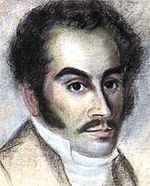
Bolívar returned to Venezuela in 1807.
In 1813 he was given a military command in Tunja, New Granada (modern day Colombia), under the direction of the Congress of United Provinces of New Granada, which had formed out of the juntas established in 1810.
This was the beginning of the famous Admirable Campaign. He entered Mérida on May 24, where he was proclaimed as El Libertador (The Liberator). That event was followed by the occupation of Trujillo on June 9. Six days later, on June 15, he dictated his famous Decree of War to the Death. Caracas was retaken on August 6, 1813 and Bolívar was ratified as "El Libertador", thus proclaiming the restoration of the Venezuelan republic. Due to the rebellion of José Tomás Boves in 1814 and the fall of the republic, he returned to New Granada, where he then commanded a force for the United Provinces and entered Bogotá in 1814, recapturing the city from the dissenting republican forces of Cundinamarca. He intended to march into Cartagena and enlist the aid of local forces in order to capture Royalist Santa Marta. In 1815, after a number of political and military disputes with the government of Cartagena, however, Bolívar fled to Jamaica, where he was denied support and an attempt was made on his life, after which he fled to Haiti, where he was granted sanctuary and protection. He befriended Alexandre Pétion, the leader of the newly independent country, and petitioned him for aid.
In 1816, with Haitian soldiers and vital material support (on the condition that he abolish slavery), Bolívar landed in Venezuela and their forces captured Angostura (now Ciudad Bolívar) after defeat the counter-attack of Miguel de la Torre. However Venezuela remained a captaincy of Spain after to be stopped in 1818 by victory of Pablo Morillo in Caracas. Bolívar decided that he would first fight for the independence of New Granada, to gain resources of the vice royalty, intending later to consolidate the independence of Venezuela.
The campaign for the independence of New Granada was consolidated with the victory at the Battle of Boyacá in 1819. From this newly consolidated base of power, Bolívar launched outright independence campaigns in Venezuela and Ecuador, and these campaigns were concluded with the victories at the Battle of Carabobo in 1821 and the Battle of Pichincha in 1822. On September 7, 1821 the Gran Colombia (a state covering much of modern Colombia, Panama, Venezuela, Ecuador, northern Peru, and northwest of Brazil) was created, with Bolívar as president and Francisco de Paula Santander as vice president.
On July 26 and 27, 1822, Bolívar held the Guayaquil conference with the Argentinian General José de San Martín, who had received the title of Protector of Peruvian Freedom in August 1821 after having partially liberated Peru from the Spanish. Thereafter, Bolívar took over the task of fully liberating Peru. The Peruvian congress named him dictator of Peru on February 10, 1824, which allowed Bolívar to reorganize completely the political and military administration. Assisted by Antonio José de Sucre, Bolívar decisively defeated the Spanish cavalry at the Battle of Junín on August 6, 1824. Sucre destroyed the still numerically superior remnants of the Spanish forces at Ayacucho on December 9, 1824.
On August 6, 1825, at the Congress of Upper Peru, the "Republic of Bolivia" was created. Bolívar is thus one of the few men to have a country named after him.
Proclamation of dictatorial power
Bolívar had great difficulties maintaining control of the vast Gran Colombia. In 1826, internal divisions had sparked dissent throughout the nation, and regional uprisings erupted in Venezuela. The new South American union had revealed its fragility and appeared to be on the verge of collapse. To preserve the union, an amnesty was declared and an arrangement was reached with the Venezuelan rebels, but this increased the political dissent in neighboring New Granada. In an attempt to keep the nation together as a single entity, Bolívar called for a constitutional convention at Ocaña in March 1828.
Bolívar's dream had been to engender an American Revolution-style federation among all the newly independent republics, with a government set up solely to recognize and uphold the rights of the individual. This dream had succumbed to the pressures of particular interests throughout the region, which rejected that model and had little or no allegiance to liberal principles. For this reason, and to prevent a break-up, Bolívar sought to implement a more centralist model of government in Gran Colombia, including some or all of the elements of the Bolivian constitution he had written, which included a lifetime presidency with the ability to select a successor (although theoretically, this presidency was held in check by an intricate system of balances). This move was considered controversial in New Granada and was one of the reasons the deliberations, which met from April 9 to June 10, 1828. The convention almost ended up drafting a document which would have implemented a radically federalist form of government, which would have greatly reduced the powers of a central administration. Unhappy with what would be the ensuing result, pro-Bolívar delegates withdrew from the convention, leaving it moribund.
After the failure of this congress to write a new constitution, Bolívar proclaimed himself dictator on August 27, 1828 through the Decree of Dictatorship. He considered this as a temporary measure, as a means to reestablish his authority and save the republic, although it increased dissatisfaction and anger among his political opponents. An assassination attempt on September 25, 1828 failed, thanks to the help of his lover, Manuela Sáenz. Bolívar afterward described Manuela as Libertadora del Libertador (the liberator of the liberator). Although Bolívar emerged safely from the attempt, this nevertheless greatly affected him. Dissent continued, and uprisings occurred in New Granada, Venezuela, and Ecuador during the next two years.
Death
Saying, "All who served the Revolution have plowed the sea," Bolívar finally resigned his presidency on April 27, 1830, intending to leave the country for exile in Europe, possibly in France. He already had sent several crates (containing his belongings and writings, which he had selected) ahead of him to Europe, but he died before setting sail.
On December 17, 1830, at the age of forty-seven, Simón Bolívar died after a painful battle with tuberculosis in the Quinta de San Pedro Alejandrino in Santa Marta, Gran Colombia (now Colombia). On his deathbed, Bolívar asked his aide-de-camp, General Daniel F. O'Leary to burn the remaining, extensive archive of his writings, letters, and speeches. O'Leary disobeyed the order and his writings survived, providing historians with a wealth of information about Bolívar's liberal philosophy and thought, as well as details of his personal life, such as his long love affair with Manuela Sáenz. Shortly before her own death in 1856, Sáenz augmented this collection by giving O'Leary her own letters from Bolívar.
His remains were buried in the cathedral of Santa Marta. Twelve years later, in 1842, at the request of President José Antonio Páez, they were moved from Santa Marta to Caracas, where a monument was set up for his interment in the National Pantheon of Venezuela. The 'Quinta' near Santa Marta has been preserved as a museum with numerous references to his life. In 2010, symbolic remains of Bolívar's lover, Manuela Sáenz, were interred by his side during a national ceremony reuniting them and honoring her role in the liberations.
On January 2008, then President of Venezuela Hugo Chávez set up a commission to investigate theories that Bolívar was the victim of an assassination. On several occasions, Chavez has claimed that Bolívar was in fact poisoned by "New Granada traitors". In April 2010, infectious diseases specialist Paul Auwaerter studied records of Bolívar's symptoms and concluded that he might have suffered from chronic arsenic poisoning, but that both acute poisoning and murder were unlikely. In July 2010, Bolívar's body was ordered to be exhumed to advance the investigations. In July 2011, international forensics experts released their report claiming that there was no proof of poisoning or other unnatural cause of death.
Private life
In 1799, following the early deaths of his father Juan Vicente (died 1786) and his mother Concepción (died 1792), he traveled to Mexico, France, and Spain, at age sixteen, to complete his education. While in Madrid during 1802, he married María Teresa Rodríguez del Toro y Alaiza, who was his only wife. She was related to the family of the Marqués del Toro of Caracas. Eight months after returning to Venezuela with him, she died from yellow fever. Bolívar returned to Europe in 1804, where he lived in Napoleonic France for a while and undertook the Grand Tour. During this time in Europe, he is supposed to have met Alexander von Humboldt in Paris. Humboldt wrote in 1804 of having met a young man in Paris, having noticed his love of liberty and lively conversation, but having remained unimpressed by him.
Relatives
Bolívar had no children, having contracted measles and mumps as a child. His closest living relatives descend from his sisters and brother. One of his sisters died in infancy. His sister Juana Bolívar y Palacios married their maternal uncle, Dionisio Palacios y Blanco, and had two children, Guillermo and Benigna. Guillermo Palacios died fighting alongside his uncle Simón in the battle of La Hogaza on December 2, 1817. Benigna had two marriages, the first to Pedro Briceño Méndez and the second to Pedro Amestoy. Their great-grandchildren, Bolívar's closest living relatives, Pedro, and Eduardo Mendoza Goiticoa lived in Caracas, as of 2009. The family still lives in Caracas today.
His eldest sister, María Antonia, married Pablo Clemente Francia and had four children: Josefa, Anacleto, Valentina, and Pablo. María Antonia became Bolívar's agent to deal with his properties while he served as president of Gran Colombia and she was an executrix of his will. She retired to Bolívar's estate in Macarao, which she inherited from him.
His older brother, Juan Vicente, who died in 1811 on a diplomatic mission to the United States, had three children born out of wedlock whom he recognized: Juan, Fernando Simón, and Felicia Bolívar Tinoco. Bolívar provided for the children and their mother after his brother's death. Bolívar was especially close to Fernando and in 1822 sent him to study in the United States, where he attended the University of Virginia. In his long life, Fernando had minor participation in some of the major political events of Venezuelan history and also traveled and lived extensively throughout Europe. He had three children, Benjamín Bolívar Gauthier, Santiago Hernández Bolívar, and Claudio Bolívar Taraja. Fernando died in 1898 at the age of 88.
Political beliefs
He was an admirer of both the American Revolution and the French Revolution. In fact, George Washington and Bolívar shared the same objective: independence for their people and the establishment of democratic states. He admired Thomas Jefferson and sent his nephew to the University of Virginia, which was founded and designed by Jefferson. Bolívar differed, however, in political philosophy from the leaders of the revolution in the United States on two important matters. First of all, he was staunchly anti-slavery, despite coming from an area of Spanish America that relied heavily on slave labor. Second, while he was an admirer of the American independence, he did not believe that its governmental system could function in Latin America. Thus, he claimed that the governance of heterogeneous societies like Venezuela "will require an infinitely firm hand."
He felt that the US had been established in land especially fertile for democracy. By contrast, he referred to Spanish America as having been subject to the "triple yoke of ignorance, tyranny, and vice." If a republic could be established in such a land, in his mind, it would have to make some concessions in terms of liberty. This is shown when Bolívar blamed the fall of the first republic on his subordinates trying to imitate "some ethereal republic" and in the process, not paying attention to the gritty political reality of South America.
Among the books accompanying him as he traveled were, Adam Smith's " The Wealth of Nations", Voltaire's "Letters", and when he wrote the Bolivian Constitution, Montesquieu's Spirit of the Laws. His Bolivian constitution placed him within the camp of what would become Latin American conservatism in the later nineteenth century. The Bolivian Constitution had a lifelong presidency and a hereditary senate, essentially recreating the British unwritten constitution, as it existed at the time, without formally establishing a monarchy. It was his attempts to implement a similar constitution in Gran Colombia that led to his downfall and rejection by 1830.
Regarding his immigration policy for Colombia, he viewed the immigration of North-Americans and Europeans (except for the Spanish, who were expelled) as necessary to improve the country's economy, arts, and sciences, following the steps of the Latin-American criollo elites, who accepted without question many of the evolutionist, social, and racial theories of their time.
Freemasonry
Similar to some others in the history of American Independence (George Washington, Benito Juárez, José de San Martín, Bernardo O'Higgins and Francisco Miranda), Simón Bolívar was a Freemason. He was initiated in 1803 in the Masonic Lodge Lautaro which operated in Cadiz, Spain. It was in this lodge that he first met some of his revolutionary peers, such as José de San Martín. In May 1806 he was conferred the rank of Master Mason in the "Scottish Mother of St. Alexander of Scotland" in Paris. During his time in London, he frequented "The Great American Reunion" lodge in London, founded by Francisco de Miranda. In April 1824, Simón Bolívar was given the 33rd degree of Inspector General Honorary.
Legacy

Political legacy
Bolívar's political legacy has been massive and he is a very important figure in South American political history. The ' Bolivarianism' of the last two decades, such as in the Venezuela of Hugo Chávez, tries to evoke the memory of Bolívar, using a left-wing view of his writings and supposed ambitions as the basis for a political movement. However, some critics, including descendants of Bolivar, state that Bolívar would have rejected these positions.
After his defeat and early death, it took more than a decade to rehabilitate his lost image in South America. By the 1840s, the memory of Bolívar proved useful for the construction of a sense of nationhood. In Venezuela, in particular, a type of cult to Bolívar appeared, first under the President José Antonio Páez and most dramatically under President Antonio Guzmán Blanco. Since the image of Bolívar became central to the national identities of Venezuela, Colombia, Panama, Ecuador, Peru, and Bolivia, his mantle is claimed by nearly all politicians from all parts of the political spectrum. Bolivia and Venezuela (the Bolívarian Republic of Venezuela) are both named after Bolívar.
Things named after him
The nation of Bolivia is named after Bolívar.
Most cities and towns in Venezuela and Colombia have a bust or statue of Bolívar.
In Venezuela, every city or town has a main square known as Plaza Bolívar.
- Bilbao ( Basque Country, Spain), "Simón Bolívar Street", a street in Bilbao city centre to honour Bolívar and his Basque ancestry and a monument at Venezuela square.
- The main square in Bogotá, Colombia is called plaza de Bolívar ( Bolivar Square), around this square rise the Colombian national capitol, the Colombian palace of justice, the palace of lievano( which houses the mayor of Bogotá ), and the main cathedral of the city.
- Bolivar ( Basque Country, Spain), Bolívar's ancestor's home town; a monument to Bolívar, a gift by Venezuela. A museum devoted to Simón Bolívar, his family and ancestors was built in Simón Bolívar's patrimonial house.
- Currencies, the boliviano and the Venezuelan bolívar
- The Venezuelan Navy has a sail traing barque named after him.
- USS Simon Bolivar, a Benjamin Franklin class fleet ballistic missile submarine
- A square near Tahrir Square in the downtown of Cairo, Egypt is named after him.
